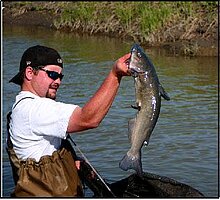The Examination of Life History Variation in White Sucker (Catostomus commersoni) Populations in North Dakota and Minnesota Drainages

Will Clark is second-year doctoral student at North Dakota State University (NDSU) in the Department of Biological Sciences, working toward a degree in Zoology with an emphasis in aquatic ecology and physiology. He completed a M.S. degree in 2004, working under the advisement of Dr. William J. Bleier (NDSU), he researched the effect of aerial lines on red-winged blackbird (Agelaius phoeniceus) behavior and nesting success. In 2002 he completed a B.S. in biology at Central Washington University under the advisement of Dr. Daniel Beck. His doctoral research focuses on the examination of life history tradeoffs in White Sucker (Catostomus commersoni) populations through out North Dakota and Minnesota
Email: William.Clark@ndsu.edu
Fellow: William Clark, Department of Biological Sciences, North Dakota State University
Advisor: Dr. Mark E. Clark, Assistant Professor of Biology, North Dakota State University
Matching Support: NDSU
Degree Progress: Ph.D. in Zoology expected Spring 2009
The Examination of Life History Variation in White Sucker (Catostomus commersoni) Populations in North Dakota and Minnesota Drainages
The mechanisms by which landscape level changes affect populations and communities are poorly understood, partly because of the complex relationships between biological species and their environments. Predicting the changes in population state associated with habitat alteration is of considerable interest to land managers. Munkittrick and Dixon (1989) argue that the status of a fish population is a reflection of the overall condition of the aquatic environment in which that population resides. Therefore, fish population characteristics can and should be used as indicators of aquatic ecosystem health. Changes to the aquatic environment may act both directly (e.g., as temperature increases, metabolism increases) and indirectly (e.g., as light levels decrease zooplankton productivity may decrease, which reduces food resources for fish) on an individual fish (Dodson, 2005). Ultimately stress due to environmental change alters growth, reproduction, and survival of individual fish. That is, environmental perturbations lead to changes in basic life history traits of fishes, which in turn affect population state and population viability (Moyle and Cech, 2004). Furthermore, life history traits can be viewed as constrained by energy allocation for growth, maintenance and reproduction at the individual level (Vandermeer and Goldberg 2003, Stearns 1992). Hence, environmental disturbance to aquatic habitats could be measured through energy allocation by individual fishes.
White suckers (Catostomus commersoni) are abundant throughout the North Dakota – Minnesota region (Phillips et al. 1982, Stewart and Lindsey 1983, Koel 1997), and have been used to assess a variety of large-scale environmental changes in aquatic ecosystems (mining: Munkittrick and Dixon 1988, 1989a, McFarlane and Franzin 1978; water chemistry: Trippel and Harvey 1987; radionuclides: Swanson 1982). In 1995, Gagon et al. found that white suckers exposed to bleached-kraft mill effluent had a greater length at maturity, reduced gonad size, and more variable fecundity, ultimately resulting in a reduction in reproduction. Furthermore, variation in age and length at maturity of white suckers can be affected by food availability, population density, water temperature, and water quality (Trippel and Harvey 1987, Wakefield and Beckman, 2005).
Because white sucker populations occur in almost every North Dakota and Minnesota River drainage (Phillips et al. 1982, Stewart and Lindsey 1983) they provide a model for exploring how landscape-level environmental differences are related to biological changes in resource allocation at the individual level. By examining populations throughout North Dakota and Minnesota to quantify individual growth, reproductive effort and physiology, a unique opportunity exists to determine correlations between life-history gradients and environmental gradients.
Project Objectives:
I propose a research program that examines variation in individual growth (size at age, length-weight ratio, body lipid levels), reproductive effort (gonad: body mass ratio, age at maturation, tubercle development) and physiology (metabolic rate, immune function) in white sucker populations distributed in North Dakota and Minnesota. In addition, I will quantify relationships among watershed landcover, hydrology, and temperature and variation in white sucker life-history traits.
Progress to Date:
Currently I have finished my first field season and am in the process of working on analysis of growth rates, immune system components, and reproductive effort. In 2006 I collected fish from 18 watersheds in North Dakota and intend to expand this to 28 watersheds. I am also conducting an in-depth literature review on white sucker life history traits, fish physiology, and aquatic ecosystem ecology that I intend to submit for publication. This summer I will start to quantify landscape attributes in sampled watersheds (GIS), and obtain hydrological variables and temperature values for the sampled watersheds.
Significance:
As landscape alteration and the use of water resources continue, the ability to maintain sustainable aquatic ecosystems depends on an understanding of the relationships between individual organisms and their environment. I anticipate that results from this study will demonstrate connections between resource allocation and environmental conditions. By understanding constraints regulating life-history traits via resource allocation at the individual level, biologists can better predict effects of habitat alteration on aquatic vertebrates. For instance, if high parasitic infection rates (and adult reduced survival) in white sucker populations under particular environmental conditions are offset by large investments in offspring, landscape level changes in watershed hydrology that reduce offspring survival (e.g., increased silt load due to channelization) may threaten population viability because payoffs in offspring investment are compromised, however changes that affect adult growth rates (e.g., elevated metabolic costs associated with higher flow) may not cause a population collapse.

Mark Clark
Biological Sciences
Office: Stevens 119
Telephone: 701-231-8246
Email: m.e.clark@ndus.edu


